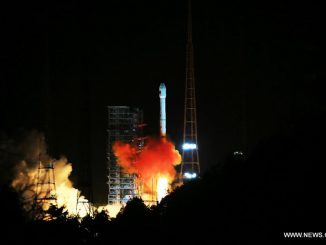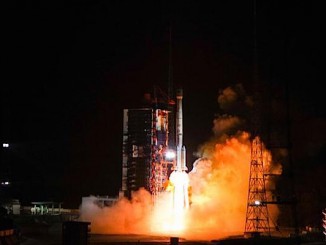
A Chinese spacecraft ferrying rocks drilled from the moon’s surface is on course to land back on Earth Wednesday and deliver the first fresh lunar samples to scientists since the 1970s.
The Chang’e 5 mission’s return spacecraft is in the home stretch of a 23-day mission that successfully launched on China’s most powerful rocket Nov. 23, landed on the moon Dec. 1, collected samples, then took off again Dec. 3 to accomplish the first automated docking between two robotic spacecraft around another planetary body.
Chang’e 5’s ascender vehicle linked up with the mission’s return spacecraft Dec. 5, then transferred the capsule containing the moon rocks to the return craft before jettisoning and intentionally crashing into the moon Dec. 7.
With those steps completed, all that’s left is to bring the lunar samples back to Earth.
Chang’e 5’s return spacecraft fired thrusters to raise its orbit around the moon on Friday, then performed a final departure maneuver at 8:51 p.m. EST Saturday (0151 GMT Sunday) to head for Earth, according to the China National Space Administration. The 22-minute maneuver with four small thrusters provided the impulse necessary for the Chang’e 5 return craft to break free of the moon’s gravity.
The probe completed a course correction burn Monday and continued cruising toward Earth Tuesday, aiming for a landing in China’s Inner Mongolia region Wednesday.
Chinese officials have not disclosed the exact landing time, but public notices directing pilots to steer clear of the mission’s recovery zone are active from 12:32 p.m. until 1:07 p.m. EST (1732-1807 GMT) — in the middle of the night in the remote landing area.
Chang’e 5’s return spacecraft will release the capsule carrying the moon rocks before entering the atmosphere.
The re-entry capsule will bounce off the atmosphere in a “skip re-entry” to slow the craft down before landing, diminishing its initial entry velocity from 25,000 mph, or 40,000 kilometers per hour, significantly faster than a re-entry from low Earth orbit. The skip re-entry will help reduce heat the landing capsule will encounter during descent, Chinese officials said, before the craft deploys a parachute for landing.

Chinese recovery crews in Inner Mongolia are preparing for the arrival of the lunar samples, Chinese state media reported Tuesday.
The Chang’e 5 sample return mission, if successful, will mark the first round-trip flight to the moon in 44 years. It is the first tmie lunar material has been returned to Earth since 1976, when the Soviet Union’s robotic Luna 24 mission brought back around 170 grams, or 6 ounces, of specimens from the lunar surface.
Nine missions have returned moon samples to Earth, including NASA’s six Apollo missions with astronauts, and three robotic Luna spacecraft launched by the Soviet Union. NASA’s Apollo missions brought back 842 pounds (382 kilograms) of rocks from the moon.
Chinese scientists will take the lunar material to a climate-controlled facility to begin analyses on the rocks. Researchers hope to learn about the moon’s history and evolution.
The Chang’e 5 mission’s goal was to collect more than 4 pounds, or 2 kilograms, of rocks for return to Earth. Chinese officials have not released an estimate of how much material the spacecraft gathered on the moon.
The Chang’e lunar program is named for a moon goddess in Chinese folklore.
The sample return mission follows earlier feats in China’s lunar exploration program. Most recently, the Chang’e 4 mission performed the first successful soft landing on the far side of the moon in January 2019. Chang’e 4 uses a dedicated data relay satellite flying in deep space to bounce commands and scientific data between ground teams and the spacecraft on the lunar surface.
China’s next lunar mission, Chang’e 6, is similar to Chang’e 5. It might attempt a sample return mission to retrieve lunar rocks from a location near the moon’s south pole around 2023.
Email the author.
Follow Stephen Clark on Twitter: @StephenClark1.



